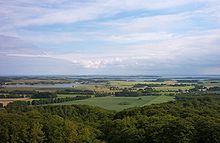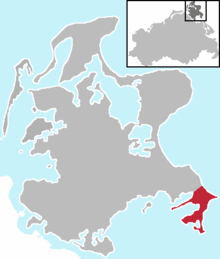Mönchgut




Mönchgut ( Low German Mönnichgaud ) is a 29.44 square kilometer peninsula in the southeast of the German Baltic Sea - the island of Rügen in Mecklenburg-Western Pomerania . It separates the Greifswalder Bodden from the Baltic Sea.
geography
On Mönchgut are the places Göhren , Baabe , Lobbe , Middelhagen , Gager , Groß Zicker, Klein Zicker and Thiessow ; the peninsula is part of the Mönchgut-Granitz district . The Mönchgut belongs entirely to the Southeast Rügen Biosphere Reserve and the majority of the Mönchgut nature reserve .
The peninsula consists of several headlands such as the Reddevitz peninsula , the Kleiner and Großer Zicker . The bay between Rügen and the Reddevitzer Höft is called Having . The one between the Reddevitz peninsula and the Großer Zicker is the Hagensche Wiek , the Zicker See separates the Großer Zicker from the Kleiner Zicker. To the east, the island of Greifswalder Oie is in front of the peninsula.
The peninsula has an elevation of 66 meters with the Bakenberg . Mönchgut is about 10 kilometers long and 3 kilometers wide. Its coastline is 53 kilometers long.
history
The peninsula got its name in the Middle Ages when it belonged to the Eldena monastery near Greifswald. Prince Jaromar II of Rügen had given the land of Reddevitz , which forms the greater part of the peninsula, to the monastery in 1252. Abbot Martin von Eldena bought the rest of the southern part of the peninsula from the Bonow family in 1360 for only 3,180 marks . Since then the peninsula has been called "Mönchegud". The monastery separated its property from the rest of Rügen by the Mönchsgraben north of Baabe . After the Reformation of 1534, Mönchgut fell to the sovereign, the dukes of Pomerania-Wolgast.
Until the end of the 19th century, the inhabitants of the area lived mainly from fishing and piloting activities . The local writer Ina Rex described her everyday life and the beginning of the end of the rural period in her novel Nivellierarbeit der Zeit from 1910 based on the life of a farmer's daughter from Groß Zicker in the conservative milieu on Mönchgut. Well-known Mönchgut homeland researchers were Fritz Worm and Willy Dumrath .
Attractions
Today the area is mainly dependent on tourism. One of the attractions is the local history museum in Göhren . The open-air museum is located on old settlements and illustrates the history of the peninsula. There is also an exhibition of magnificent traditional costumes that Mönchgut is known for and that are still worn at folklore performances. At Göhren you can visit the Buskam , one of the largest boulders . One of the more than 54 megalithic tombs still preserved on Rügen is located on Mönchgut . The ducal grave in Mönchguter Forest was rediscovered in 1920 and archaeologically examined from 1922 to 1924 and 1962. Seven more such megalithic systems can be viewed in the nearby town of Lancken-Granitz ( megalithic graves near Lancken-Granitz ). Several remains of jumps from the 17th to 19th centuries have also been preserved as ground monuments.
The Lobbe wind pumping station between Middelhagen and Lobbe was one of the few wind turbines that acted as a pumping station. It was toppled by a storm in November 2018. It is a technical monument and is to be rebuilt with donations. Göhren is the terminus of the steam-powered narrow - gauge railway Rasender Roland , also a technical monument.
Others
Mönchgut is also the name of a ship that operates between Rügen, Usedom and Greifswald .
literature
- Norbert Buske : Churches on Mönchgut. A guide through the building and church history of places of worship . Evangelische Verlags-Anstalt, Berlin 1987, ISBN 3-374-00207-2 .
- Ruth Bahls among others: Mönchgut - a landscape study. Overviews of natural and cultural history and walks , Göhren, Greifswald 1990.
- Andre Kobsch, Gerhard Parchow: Mönchgut and Granitz . Sutton, Erfurt 2000, ISBN 3-89702-253-2 . (Annotated archive photos and postcards 1890–1950)
- Lutz Mohr : Greifswald-Eldena and the monastery Hilda ... . Neue Greifswalder Museumhefte , issue 1/1977, 2nd revised. Edition 1979, numerous. Literature and Tables
- Hans Georg Prager, Michael Hammermeister: 750 years of Mönchgut. In: Pomerania. Journal of Culture and History. Issue 1/2002, ISSN 0032-4167 , pp. 10-15.
- Hans Georg Prager , Michael Hammermeister: Mönchgut - Cistercian Vorwerk shaped a landscape of Rügen . In: Die Pommersche Zeitung , volume 66, episode 51/52 of 23 September 2016, p. 21, literature
- Rolf Reinicke: Mönchgut. Magic of a Rügen landscape . 2nd Edition. Konrad Reich publishing house, Rostock 1997, ISBN 3-86167-047-X .
- Ina Rex: leveling the time . Novel. Janssen, Hamburg 1910. New edition: Reprint-Verlag, Bergen auf Rügen 1999.
- Evangelical parish Groß Zicker (Ed.): 750 years of Mönchgut. 1252-2002. Selected lectures from the anniversary year . Gross Zicker 2004.
Individual evidence
- ↑ https://www.projekt-gutenberg.org/laube/pommern/pomm06.html
- ↑ a b Heinz Lehmann, Renate Meyer: Rügen A – Z. From Arkona to Zudar . Ernst Wähmann, Schwerin 1976. p. 54.
- ↑ Rescue for Lobbe wind pumping station started. In: ostsee-zeitung.de. Accessed January 1, 2020 .
Web links
Coordinates: 54 ° 21 ' N , 13 ° 43' E


